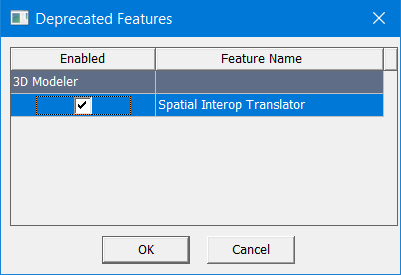Importing 3D Model Files
3D model files can be imported directly into the active Modeler window. Supported 3D model file formats are listed in the table that follows.
| Type | Extension(s) | Supported Version(s) |
| ACIS SAB | *.sab | ACIS R1 through ACIS 2023 1.0 |
| ACIS SAT | *.sat | ACIS R1 through ACIS 2023 1.0 |
| Ansoft Geometry | *.AnstGeom |
All |
| Ansys 3D Modeler | *.sm3 |
3D Modeler files in ACIS R2 through ACIS 2023 1.0 See UDMs and CAD integration with Workbench. |
| AutoCAD | *.dxf, *.dwg |
Linux: Versions 2.5 (AC1002) through 2012 (AC1024) Windows: Versions 2.5 (AC1002) through 2017 (AC1027). |
| Autodesk Inventor | *.ipt, *.iam |
Hoops: Up to V2024 Interop: V6 through V2024 |
| CATIA | *.exp, *.model, *.CATPart, *.CATproduct | V4 through V5-6R2023 |
| Creo Parametric | *.prt, *.asm |
Hoops: Pro/Engineer 19.0 to Creo 10.0 Interop: Pro/Engineer 16 – Creo 10.0 |
| IGES | *.iges, *.igs | All, through 5.3 |
| JT | *.jt |
Hoops: B-rep JT Up to 10.9 InterOp: Up to 10.7 |
| NASTRAN | *.nas | CROD, CBEAM, CTRIA3, and CQUAD4 element types |
| Siemens NX | *.prt | NX 11 through NX 2306 |
| Parasolid | *.x_t, *.x_b | 9.0 through 35.1.210 |
| SOLIDWORKS | *.SLDPRT, *.SLDASM |
Hoops: From 98 through 2024 Interop: From 98 through 2023 |
| STEP | *.step, *.stp | ISO standard 10303-21:2016, AP214 STEP files and AP242 (geometry only) |
| STL | *.stl | 2.0 (see Lightweight Geometry in SBR+) |
- Object, material, and parameter names with non-ASCII characters are not allowed for data transfer. Such transfers fail and produce an error message.
- If you import a file into an active Modeler window that contains an existing model, the file is added to the existing model; it will not replace it.
With Ansys Electronics Desktop2024R2, Hoops Exchange translators will be used by default to translate following 3D CAD files: Inventor, CATIA, Creo, IGES, JT, NX, Solidworks, and STEP. Spatial InterOp translators are deprecated for the these formats; they can be used by turning on the deprecated feature, accessed from the Tools > Options > General Options > Deprecated Features button.

To import a 3D model file:
- Click Modeler > Import.
- Select the file type you want from the Files of type drop-down menu.
-
Select any import options available for the selected file type. Options may include:
- Validation and Healing Options – See Healing an Imported Object.
- Import Material Names – use the check box to import material names.
- Import Free Surfaces – for Creo Parametric files, use the check box to import surfaces as well as parts.
- Stitch Tolerance and Units – For STEP and IEGS files, you can specify a Stitch tolerance and units. The default value (auto) comes from Healing options.
- STL Import Options – for STL files for modal or terminal solutions, select the modeling units to which the imported model is scaled and whether to merge faces that are on the same plane, and whether to Heal on import.
Heal attempts to remove common issues while importing stl files, including closing solids when they are open due to minor cracks in triangulation and removing self-intersections.

The generic format specification for STL does not include units. When Auto is selected for the file units, the current model units are normally used. The exception is for *.stl files saved from SpaceClaim, for which units have been specified.
Checking Reduce enables fields for specifying Reduce Max Error and Reduce Percentage.
- Create Groups for Sub Assembly – for formats that allow importing MCAD Assemblies as groups, use the check box to retain the assembly structure of objects using groups. For every subassembly in the model, a group is created and it retains hierarchical information by creating group hierarchy. See Group Commands for Modeler Objects.
- Use the file browser to find the file you want to import.
-
Click Open.
The file is imported into the active Modeler window.
The Import File dialog box appears.
For tips on dealing with very complex models, see Technical Notes: Handling Complicated Models.
Related Topics
Importing DXF and DWG Format Files.
Technical Notes: Handling Complicated Models
